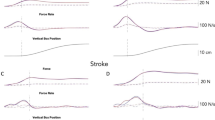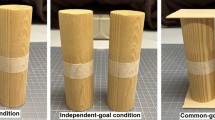Abstract
A goal of rehabilitation after stroke is to promote pre-stroke levels of arm use for every day, frequently bimanual, functional activities. We reasoned that, after a stroke, the choice to use one or both hands for bimanual tasks might depend not only on residual motor capacity, but also the specialized demands imposed by the task on the paretic hand. To capture spontaneous, task-specific choices, we covertly observed 50 pre-stroke right-handed chronic stroke survivors (25 each of left, LHD, and right-hemisphere damage, RHD) and 11 age-similar control adults and recorded their hand use strategies for two pairs of bimanual tasks with distinct demands: one with greater precision requirements (photo-album tasks), and another with greater stabilization requirements (letter-envelope tasks). The primary outcome was the choice to use one or both hands. Logistic regression was used to test the two hypotheses that the probability of choosing a bimanual strategy would be greater in those with less severe motor impairment and also in those with LHD. When collapsed across the four tasks, we found support for these hypotheses. Notably, however, the influence of these factors on bimanual choice varied based on task demands. For the photo–album pair, the probability of a bimanual strategy was greater for those with LHD compared to RHD, regardless of the degree of motor impairment. For the letter–envelope pair, we found a significant interaction between impairment and side of lesion in determining the likelihood of choosing both hands. Therefore, the manner in which side of lesion moderates the effect of impairment on hand use depends on the task.



Similar content being viewed by others
Notes
We thank an anonymous reviewer for suggesting the addition of this analysis.
References
Bailey RR, Klaesner JW, Lang CE (2014) An accelerometry-based methodology for assessment of real-world bilateral upper extremity activity. PLoS ONE. https://doi.org/10.1371/journal.pone.0103135
Bailey RR, Klaesner JW, Lang CE (2015) Quantifying real-world upper-limb activity in nondisabled adults and adults with chronic stroke. Neurorehabil Neural Repair 29:969–978. https://doi.org/10.1177/1545968315583720
Buxbaum LJ, Varghese R, Stoll H, Winstein CJ (2020) Predictors of arm nonuse in chronic stroke: a preliminary investigation. Neurorehabil Neural Repair 34:512–522. https://doi.org/10.1177/1545968320913554
Chae J, Yang G, Park BK, Labatia I (2002) Delay in initiation and termination of muscle contraction, motor impairment, and physical disability in upper limb hemiparesis. Muscle Nerve 25:568–575. https://doi.org/10.1002/mus.10061
Coelho CJ, Przybyla A, Yadav V, Sainburg RL (2013) Hemispheric differences in the control of limb dynamics: a link between arm performance asymmetries and arm selection patterns. J Neurophysiol 109:825–838. https://doi.org/10.1152/jn.00885.2012
Franck JA, Smeets RJEM, Seelen HAM (2019) Changes in actual arm-hand use in stroke patients during and after clinical rehabilitation involving a well-defined arm-hand rehabilitation program: a prospective cohort study. PLoS ONE. https://doi.org/10.1371/journal.pone.0214651
Fugl Meyer AR, Jaasko L, Leyman I (1975) The post stroke hemiplegic patient. I. A method for evaluation of physical performance. Scand J Rehabil Med 7(1):13–31
Guiard Y (1987) Asymmetric division of labor in human skilled bimanual action: the kinematic chain as a model. J Mot Behav 19:486–517. https://doi.org/10.1080/00222895.1987.10735426
Haaland KY, Mutha PK, Rinehart JK et al (2012) Relationship between arm usage and instrumental activities of daily living after unilateral stroke. Arch Phys Med Rehabil 93:1957–1962. https://doi.org/10.1016/j.apmr.2012.05.011
Han CE, Kim S, Chen S et al (2013) Quantifying arm nonuse in individuals poststroke. Neurorehabil Neural Repair 27:439–447. https://doi.org/10.1177/1545968312471904
Jones TA (2017) Motor compensation and its effects on neural reorganization after stroke. Nat Rev Neurosci 18:267–280
Kamper DG, McKenna-Cole AN, Kahn LE, Reinkensmeyer DJ (2002) Alterations in reaching after stroke and their relation to movement direction and impairment severity. Arch Phys Med Rehabil 83:702–707. https://doi.org/10.1053/apmr.2002.32446
Kantak S, Jax S, Wittenberg G (2017) Bimanual coordination: a missing piece of arm rehabilitation after stroke. Restor Neurol Neurosci 35:347–364. https://doi.org/10.3233/RNN-170737
Kilbreath SL, Heard RC (2005) Frequency of hand use in healthy older persons. Aust J Physiother 51:119–122. https://doi.org/10.1016/S0004-9514(05)70040-4
Kim S, Park H, Han CE et al (2018) Measuring habitual arm use post-stroke with a bilateral time-constrained reaching task. Front Neurol 9:1–5. https://doi.org/10.3389/fneur.2018.00883
Mamolo CM, Roy EA, Bryden PJ, Rohr LE (2004) The effects of skill demands and object position on the distribution of preferred hand reaches. Brain Cogn 55:349–351. https://doi.org/10.1016/j.bandc.2004.02.041
Mamolo CM, Roy E, a, Rohr LE, Bryden PJ, (2006) Reaching patterns across working space: the effects of handedness, task demands, and comfort levels. Laterality 11:465–492. https://doi.org/10.1080/13576500600775692
Michielsen ME, Selles RW, Stam HJ et al (2012) Quantifying nonuse in chronic stroke patients: a study into paretic, nonparetic, and bimanual upper-limb use in daily life. Arch Phys Med Rehabil 93:1975–1981. https://doi.org/10.1016/j.apmr.2012.03.016
Przybyla A, Coelho CJ, Akpinar S et al (2013) Sensorimotor performance asymmetries predict hand selection. Neuroscience. https://doi.org/10.1016/j.neuroscience.2012.10.046
Rand D, Eng JJ (2015) Predicting daily use of the affected upper extremity 1 year after stroke. J Stroke Cerebrovasc Dis 24:274–283. https://doi.org/10.1016/j.jstrokecerebrovasdis.2014.07.039
Rinehart JK, Singleton RD, Adair JC et al (2009) Arm use after left or right hemiparesis is influenced by hand preference. Stroke 40:545–550. https://doi.org/10.1161/STROKEAHA.108.528497
Sainburg RL (2002) Evidence for a dynamic-dominance hypothesis of handedness. Exp Brain Res 142:241–258. https://doi.org/10.1007/s00221-001-0913-8
Schweighofer N, Han CE, Wolf SL et al (2009) A Functional threshold for long-term use of hand and arm function can be determined: predictions from a computational model and supporting data from the extremity constraint-induced therapy evaluation (EXCITE) trial. Phys Ther. https://doi.org/10.2522/ptj.20080402
Schweighofer N, Xiao Y, Kim S et al (2015) Effort, success, and nonuse determine arm choice. J Neurophysiol 114:551–559. https://doi.org/10.1152/jn.00593.2014
Shadmehr R, De Xivry JJO, Xu-Wilson M, Shih TY (2010) Temporal discounting of reward and the cost of time in motor control. J Neurosci 30:10507–10516. https://doi.org/10.1523/JNEUROSCI.1343-10.2010
Shadmehr R, Huang HJ, Ahmed AA (2016) A representation of effort in decision-making and motor control. Curr Biol 26:1929–1934. https://doi.org/10.1016/j.cub.2016.05.065
Sterr A, Freivogel S, Schmalohr D (2002) Neurobehavioral aspects of recovery: assessment of the learned nonuse phenomenon in hemiparetic adolescents. Arch Phys Med Rehabil. https://doi.org/10.1053/apmr.2002.35660
Stone KD, Bryant DC, Gonzalez CLR (2013) Hand use for grasping in a bimanual task: evidence for different roles? Exp Brain Res 224:455–467. https://doi.org/10.1007/s00221-012-3325-z
Taub E, Crago JE, Uswatte G (1998) Constraint-induced movement therapy: a new approach to treatment in physical rehabilitation. Rehabil Psychol 43:152–170. https://doi.org/10.1037/0090-5550.43.2.152
Thrane G, Emaus N, Askim T, Anke A (2011) Arm use in patients with subacute stroke monitored by accelerometry: association with motor impairment and influence on self-dependence. J Rehabil Med 43:299–304. https://doi.org/10.2340/16501977-0676
Uswatte G, Giuliani C, Winstein C et al (2006) Validity of accelerometry for monitoring real-world arm activity in patients with subacute stroke: evidence from the extremity constraint-induced therapy evaluation trial. Arch Phys Med Rehabil 87:1340–1345. https://doi.org/10.1016/j.apmr.2006.06.006
Varghese R, Winstein CJ (2020) Relationship between motor capacity of the contralesional and ipsilesional hand depends on the side of stroke in chronic stroke survivors with mild-to-moderate impairment. Front Neurol 10:1340. https://doi.org/10.3389/fneur.2019.01340
Vega-González A, Granat MH (2005) Continuous monitoring of upper-limb activity in a free-living environment. Arch Phys Med Rehabil 86:541–548. https://doi.org/10.1016/j.apmr.2004.04.049
Winstein C, Kim B, Kim S et al (2019) Dosage matters: a phase IIb randomized controlled trial of motor therapy in the chronic phase after stroke. Stroke 50:1831–1837. https://doi.org/10.1161/STROKEAHA.118.023603
Witt JK, Proffitt DR, Epstein W (2004) Perceiving distance: a role of effort and intent. Perception. https://doi.org/10.1068/p5090
Woodbury ML, Velozo CA, Richards LG, Duncan PW (2013) Rasch analysis staging methodology to classify upper extremity movement impairment after stroke. Arch Phys Med Rehabil 94:1527–1533. https://doi.org/10.1016/j.apmr.2013.03.007
Woytowicz EJ, Whitall J, Westlake KP (2016) Age-related changes in bilateral upper extremity coordination. Curr Geriatr Rep 5:191–199. https://doi.org/10.1007/s13670-016-0184-7
Woytowicz EJ, Rietschel JC, Goodman RN et al (2017) Determining levels of upper extremity movement impairment by applying a cluster analysis to the Fugl-Meyer assessment of the upper extremity in chronic stroke. Arch Phys Med Rehabil 98:456–462. https://doi.org/10.1016/j.apmr.2016.06.023
Woytowicz EJ, Westlake KP, Whitall J, Sainburg RL (2018) Handedness results from complementary hemispheric dominance, not global hemispheric dominance: evidence from mechanically coupled bilateral movements. J Neurophysiol 120:729–740. https://doi.org/10.1152/jn.00878.2017
Yadav G, Haaland KY, Mutha PK (2019) Laterality of damage influences the relationship between impairment and arm use after stroke. J Int Neuropsychol Soc 25:470–478. https://doi.org/10.1017/S1355617718001261
Acknowledgements
Dr. Laurel Buxbaum (Moss Rehabilitation Research Institute) for contributing their dataset to this analysis. Drs. James Gordon (USC) and Robert Sainburg (Pennsylvania State University) for helpful discussions. Cassandra Castillo and Antonio Raymundo, students of the Engineering for Health Academy program, Francisco Bravo Medical Magnet High School, LAUSD, for coding the video data.
Funding
This research study is supported by the Eunice Kennedy Shriver NICHD National Center for Medical Rehabilitation Research of the National Institutes of Health under award numbers: F31HD098796 to RV and R01HD065438 to NS and CW.
Author information
Authors and Affiliations
Corresponding author
Ethics declarations
Conflict of interest
The author(s) declare that they have no competing interests.
Data and code availability
The data table and code for analysis are available on the first author’s OSF repository: https://doi.org/10.17605/osf.io/uh574.
Additional information
Communicated by Winston D Byblow.
Publisher's Note
Springer Nature remains neutral with regard to jurisdictional claims in published maps and institutional affiliations.
Electronic supplementary material
Below is the link to the electronic supplementary material.
Rights and permissions
About this article
Cite this article
Varghese, R., Kutch, J.J., Schweighofer, N. et al. The probability of choosing both hands depends on an interaction between motor capacity and limb-specific control in chronic stroke. Exp Brain Res 238, 2569–2579 (2020). https://doi.org/10.1007/s00221-020-05909-5
Received:
Accepted:
Published:
Issue Date:
DOI: https://doi.org/10.1007/s00221-020-05909-5




